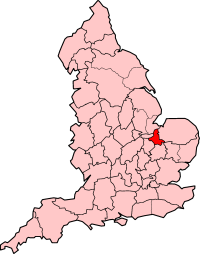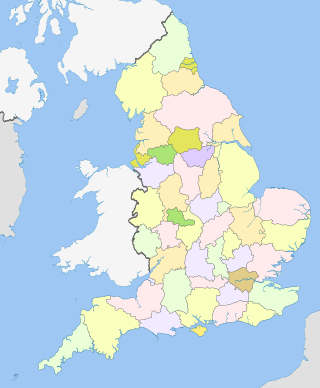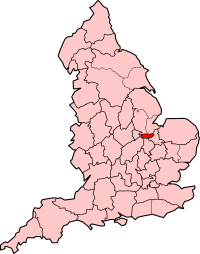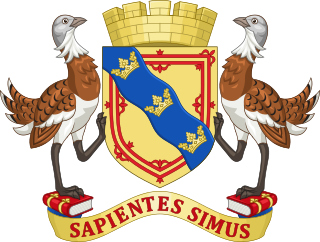
Cambridgeshire is a ceremonial county in the East of England and East Anglia. It is bordered by Lincolnshire to the north, Norfolk to the north-east, Suffolk to the east, Essex and Hertfordshire to the south, and Bedfordshire and Northamptonshire to the west. The largest settlement is the city of Peterborough, and the city of Cambridge is the county town.

The Isle of Ely is a historic region around the city of Ely in Cambridgeshire, England. Between 1889 and 1965, it formed an administrative county.

Hampshire County Council (HCC) is the upper-tier local authority for the non-metropolitan county of Hampshire in England. The council was created in 1889. The county council provides county-level services to eleven of the thirteen districts geographically located within the ceremonial county of Hampshire. The county council acts as the upper tier of local government to approximately 1.4 million people. It is one of 21 county councils in England.

The counties of England are a type of subdivision of England. Counties have been used as administrative areas in England since Anglo-Saxon times. There are three definitions of county in England: the 48 ceremonial counties used for the purposes of lieutenancy; the 84 metropolitan and non-metropolitan counties for local government; and the 39 historic counties which were used for administration until 1974.

Peterborough, or the City of Peterborough, is a local government district with city status in the ceremonial county of Cambridgeshire, England. Its council is a unitary authority, being a district council which also performs the functions of a county council. The district is named after its largest settlement, Peterborough, but also covers a wider area of outlying villages and hamlets.

The Soke of Peterborough was a historic area of England associated with the City and Diocese of Peterborough. It was part of Northamptonshire, but was administered by its own county council, while the rest of Northamptonshire was administered by Northamptonshire County Council. The Soke was also described as the Liberty of Peterborough, or as the Nassaburgh hundred, and comprised, besides Peterborough, about thirty parishes. The Soke was abolished in 1965.

Huntingdon and Peterborough was a short-lived administrative and geographical county in East Anglia in the United Kingdom. It existed from 1965 to 1974, when it became part of Cambridgeshire.

Fenland is a local government district in Cambridgeshire, England. It was historically part of the Isle of Ely. The district covers around 500 square kilometres (190 sq mi) of mostly agricultural land in the extremely flat Fens. The council is based in March. Other towns include Chatteris, Whittlesey and Wisbech.

Cambridgeshire and Isle of Ely was, from 1965 to 1974, an administrative and geographical county in East Anglia in the United Kingdom. In 1974 it became part of an enlarged Cambridgeshire.

Cambridgeshire Constabulary is the local territorial police force that covers the county of Cambridgeshire and Peterborough unitary authority. It provides law enforcement and security for an area of 1,311 square miles (3,400 km2) and population of 856,000 people, in a predominantly rural county. The force of Cambridgeshire includes the cities of Cambridge, Ely and Peterborough, the market towns of Chatteris, Huntingdon, March, Ramsey, St Ives, St Neots, Whittlesey, and town and Port of Wisbech. Its emblem is a crowned Brunswick star containing the heraldic badge of Cambridgeshire County Council.

Stanground is a residential area of Peterborough, in the ceremonial county of Cambridgeshire, England. For electoral purposes, it comprises the Stanground South and Fletton & Stanground wards in the North West Cambridgeshire constituency.
This is a list of the coats of arms of various county councils in England.

Peterborough City Council is the local authority for Peterborough, a local government district with city status in the ceremonial county of Cambridgeshire, England. Peterborough has had a council since 1874, which has been reformed several times. Since 1998 the council has been a unitary authority, being a district council which also performs the functions of a county council. Since 2017 the council has been a member of the Cambridgeshire and Peterborough Combined Authority.

Cambridgeshire County Council is the county council for non-metropolitan county of Cambridgeshire, England. The non-metropolitan county is smaller than the ceremonial county, which additionally includes the City of Peterborough. The county council consists of 61 councillors, representing 59 electoral divisions. The council is based at New Shire Hall in Alconbury Weald, near Huntingdon. It is part of the East of England Local Government Association and a constituent member of the Cambridgeshire and Peterborough Combined Authority.

Ely is a cathedral city and civil parish in the East Cambridgeshire district of Cambridgeshire, England, about 14 miles (23 km) north-northeast of Cambridge, 24 miles (39 km) south east of Peterborough and 80 miles (130 km) from London. As of the 2021 census, Ely is recorded as having a population of 19,200.

The city of Ely formed a local government district in the Isle of Ely and Cambridgeshire from 1850 to 1974. It was administered as a local board district from 1850 to 1894, and as an urban district from 1894 to 1974. Unusually for somewhere which claimed city status, Ely was not a municipal borough.

Cambridgeshire and Isle of Ely County Council was the county council of Cambridgeshire and Isle of Ely in the east of England. It came into its powers on 1 April 1965 and was abolished on 1 April 1974. The county council was based at Shire Hall, Cambridge. It was amalgamated with Huntingdon and Peterborough County Council to form an enlarged Cambridgeshire County Council in 1974.

Huntingdon and Peterborough County Council was the county council of Huntingdon and Peterborough in the east of England. It came into its powers on 1 April 1965 and was abolished on 1 April 1974. The county council was based at Walden House, Huntingdon. It was amalgamated with Cambridgeshire and Isle of Ely County Council to form an enlarged Cambridgeshire County Council in 1974.
The ceremonial county of Cambridgeshire, which includes the unitary authority of Peterborough, has returned 8 MPs to the UK Parliament since 2024.

Fenland Hall is a municipal building on County Road, March, Cambridgeshire, England, which serves as the headquarters of Fenland District Council. The building was originally called "County Hall", and was built in 1908–1909 by Isle of Ely County Council to be its meeting place and offices.



















